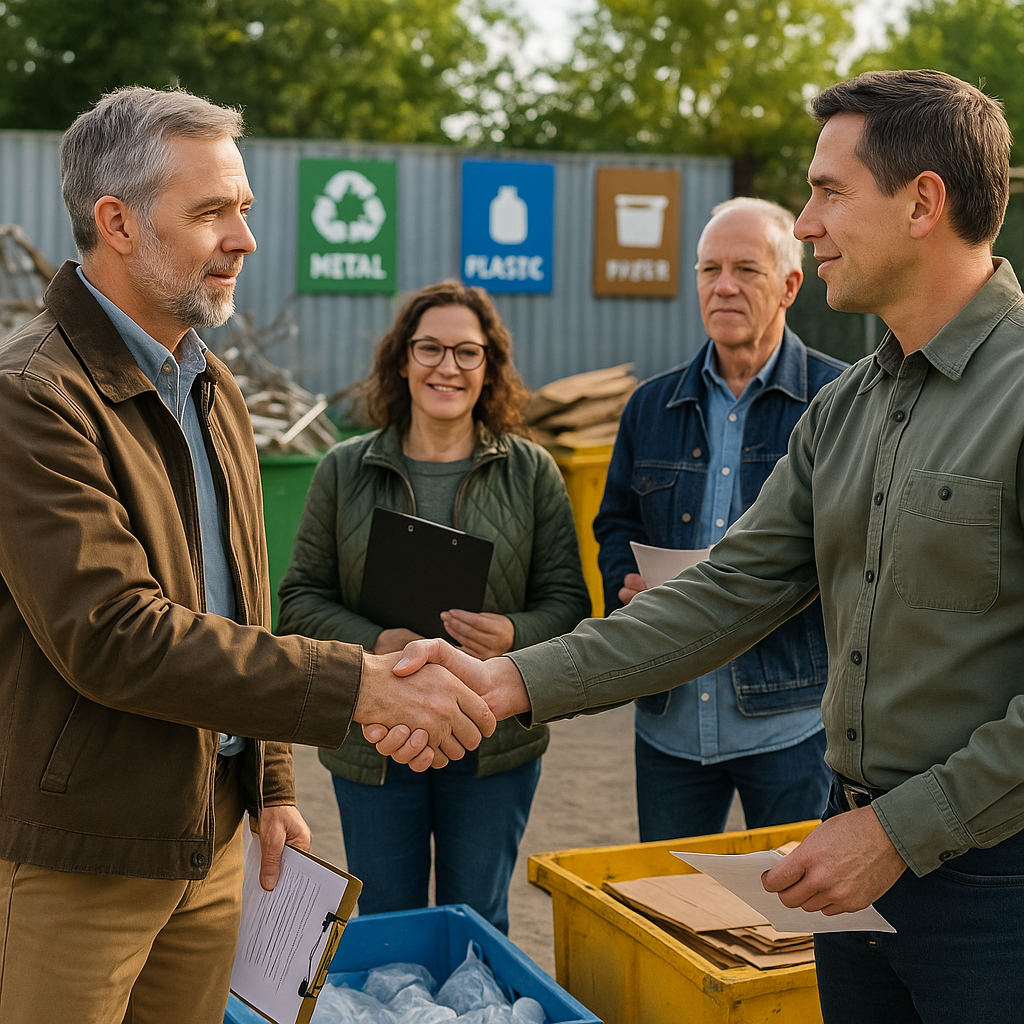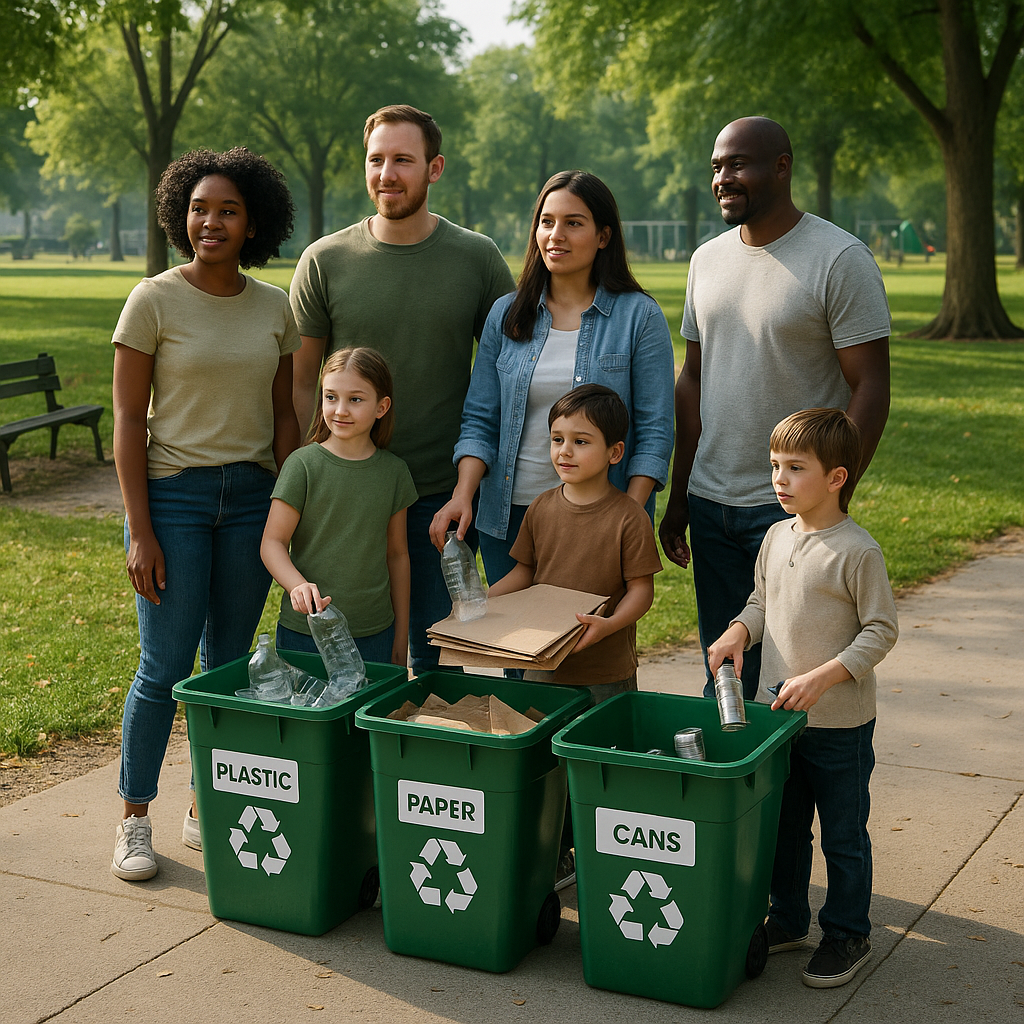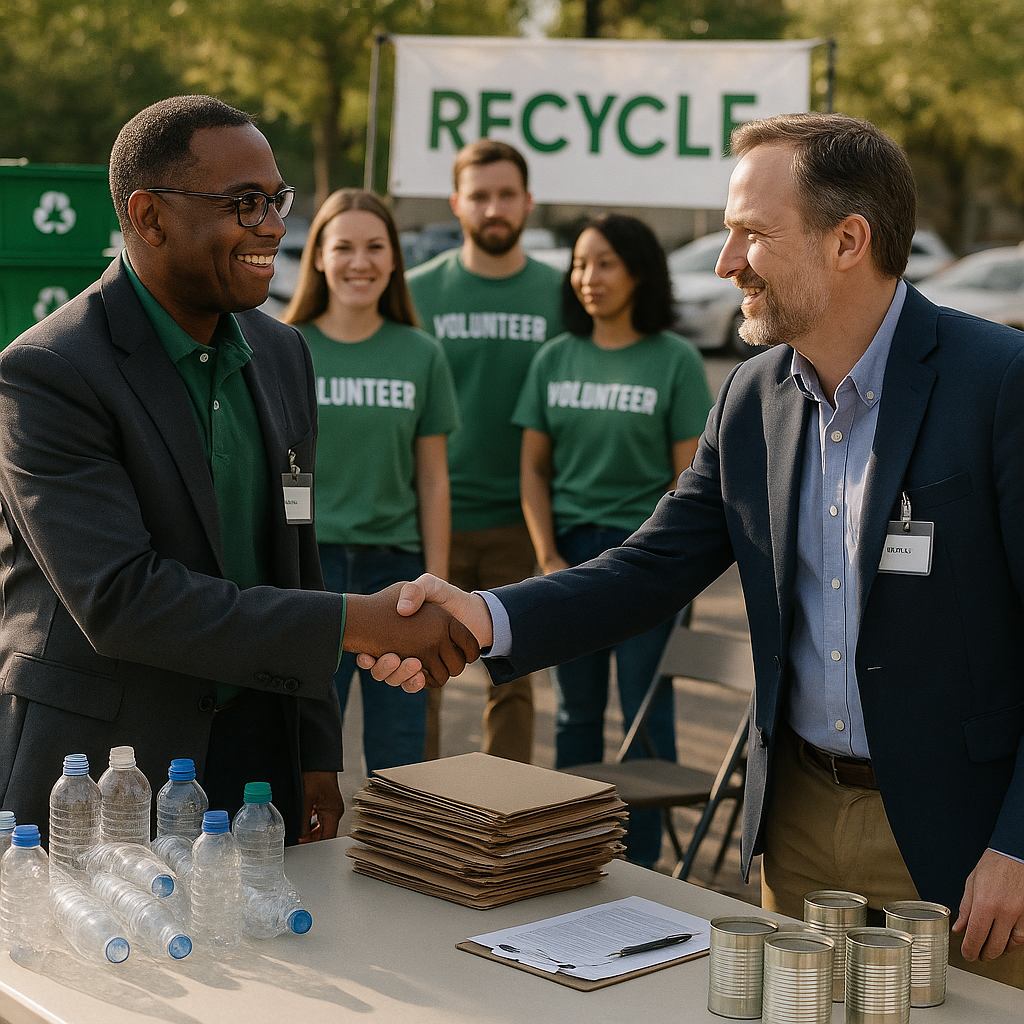5901 Botham Jean Blvd, Dallas, TX 75215
The Importance of Promoting Community Scrap Initiatives
June 13, 2025Americans generate over 292 million tons of municipal solid waste annually, with only about 32% being recycled. Community scrap initiatives can increase this recycling rate by up to 25% in participating neighborhoods. These grassroots programs offer a powerful solution to our growing waste crisis.
Community scrap initiatives are crucial for promoting sustainability and environmental stewardship. These programs involve collecting and recycling scrap materials within communities, reducing waste, conserving valuable resources, and fostering environmental responsibility. Their impact goes beyond waste diversion, strengthening community bonds through shared environmental goals.
As communities face increasing waste management challenges, promoting local scrap initiatives is essential for creating sustainable neighborhoods. The Environmental Protection Agency acknowledges these community-led programs as vital in achieving national waste reduction targets. When residents actively participate in local recycling efforts, they contribute to significant environmental improvements while fostering more environmentally conscious communities.
How Do Partnerships Enhance Community Scrap Programs?

Partnerships between industry, environmental groups, and local governments form a strong foundation for effective community scrap programs. These collaborations combine diverse expertise and resources to tackle recycling challenges. When well-structured, partnerships can transform how communities manage materials recovery and waste.
The strength of industry-government-nonprofit partnerships lies in leveraging complementary strengths. Businesses bring operational expertise and market access. Environmental organizations offer specialized knowledge and community trust. Local governments provide infrastructure, funding, and policy support. This combined approach achieves results that no single entity could accomplish alone.
Resource Sharing and Cost Efficiency
One major advantage of partnerships in scrap initiatives is efficient resource allocation. Collaboration allows participants to share costs, equipment, and expertise, which is especially valuable for smaller communities with limited budgets. Industry partners often provide collection points or processing technology that would be too costly for local governments to implement independently.
Resource sharing extends beyond physical assets. Knowledge transfer between partners fosters innovation and problem-solving. Technical expertise from the recycling industry helps communities implement more effective collection systems, reducing operational costs while maximizing material recovery.
- Reduced capital investment through shared equipment and facilities
- Lower operating costs through economies of scale
- Access to industry expertise for process optimization
- Enhanced funding opportunities through diverse partnership grant applications
- Improved supply chain management through industry connections
Educational Outreach and Community Engagement
Nonprofit partnerships are crucial for community education and engagement. These organizations bridge the gap between recycling operations and public understanding. Through targeted outreach programs, nonprofits help residents know what materials can be recycled and how to prepare them properly, reducing contamination rates and increasing participation.
Community engagement strategies developed through partnerships foster a sense of ownership among residents. When people understand the economic and environmental benefits of scrap recycling, they become active participants. Environmental groups often bring established community connections and communication channels that effectively spread awareness beyond government messaging alone.
Innovation and Adaptability
Partnerships foster innovation by uniting stakeholders with different perspectives. Industry partners introduce cutting-edge technology and market insights. Environmental groups identify emerging sustainability challenges. Local governments understand community needs and limitations. This diverse input encourages creative solutions.
The collaborative approach also enhances adaptability. Recycling markets change rapidly, and regulations evolve. Through partnerships, community scrap programs can quickly respond to these changes. Industry participants provide market intelligence that helps adjust collection strategies to focus on materials with stable demand and value, ensuring program sustainability during market fluctuations.
| Economic Benefits | Environmental Benefits |
|---|---|
| Revenue generation ($450,000+ in Greenville case study) | Reduced landfill waste (up to 25% increase in recycling rates) |
| Job creation in collection, processing, and manufacturing | Conservation of natural resources through reduced mining |
| Reduced capital investment through shared equipment | Protection against contamination and leachate formation |
| Lower operating costs through economies of scale | Reduction in greenhouse gas emissions |
| Cost-effective production for businesses using recycled materials | Decreased energy consumption (up to 95% for aluminum) |
| Enhanced funding opportunities through partnership grants | Reduced air and water pollution (86% and 76% respectively) |
| Improved supply chain management | Support for circular economy principles |
Case Study: The RecyclePartner Initiative in Greenville
The RecyclePartner Initiative in Greenville showcases the transformative potential of strategic partnerships in community scrap programs. This collaboration between a regional manufacturing association, three environmental nonprofits, and six municipal governments revitalized scrap metal collection throughout the county.
Before the partnership, Greenville’s scrap metal recycling rate was below 30%, with most materials ending up in landfills. The manufacturing association provided collection containers at member facilities and covered transportation costs. Environmental groups conducted education campaigns targeting households and small businesses. Local governments streamlined regulations and created central drop-off facilities.
Within two years, the metal recycling rate increased to 68%. The program generated over $450,000 in revenue for community sustainability projects and created a replicable model for other communities. The initiative demonstrates how partnerships can overcome traditional barriers to effective scrap recycling programs.
Policy Development and Advocacy
Partnerships strengthen community scrap initiatives through coordinated policy development and advocacy. Industry partners provide insights into how regulations affect operations. Environmental organizations contribute research on best practices and environmental impacts. Together, they advocate for policies promoting sustainable materials management while remaining economically viable.
This collaborative approach to policy development creates more robust frameworks for scrap recycling. Instead of fragmented regulations, partners work toward consistent standards benefiting all stakeholders. The unified voice of diverse partners also carries more weight with policymakers, increasing the likelihood that recommended changes will be implemented.
What Strategies Can Increase Community Participation in Scrap Initiatives?

A hopeful gathering of individuals working towards a clean community park with ample recycling bins.
Successful scrap initiatives require active community involvement. Building a robust recycling program depends on engaging community members through clear communication and accessible options. Effective strategies can transform lukewarm interest into enthusiastic participation.
Educational Workshops and Training Sessions
Regular workshops provide essential knowledge about scrap recycling practices. These sessions help residents understand what materials can be recycled and how to prepare them properly. Workshops should focus on practical demonstrations that show the entire recycling process.
Hands-on training allows participants to learn proper sorting techniques firsthand. Offering workshops at various times accommodates different schedules, ensuring maximum community participation regardless of work or family commitments.
Recording these educational sessions makes the content available to those who cannot attend in person. Sharing these recordings through community channels extends their reach and impact beyond the initial event.
Creating Effective Incentive Programs
Incentives motivate community members to participate in scrap initiatives regularly. Financial rewards like rebates or discounts for active recyclers provide immediate benefits that encourage consistent participation.
Recognition programs that highlight neighborhood champions can foster healthy competition and pride. Community leaderboards or monthly sustainability awards acknowledge those making significant contributions to local recycling efforts.
Some communities have found success with point-based systems where recycling activities earn credits toward local services. These structures help residents see the personal benefits of participating in community scrap programs.
Collaborating With Local Schools
Schools offer ideal environments for fostering recycling habits in younger generations. Integrating recycling education into school curricula helps students develop sustainable practices early on.
Student-led recycling clubs can organize collection drives and awareness campaigns. These initiatives empower students to take ownership of environmental stewardship while engaging their peers.
School recycling competitions between classrooms or grade levels make sustainability fun and engaging. These friendly contests often result in higher participation rates and enthusiasm that students bring home to their families.
Leveraging Social Media for Awareness
Strategic social media campaigns significantly boost community awareness of scrap initiatives. Platforms like Facebook, Instagram, and Twitter provide direct communication channels to inform residents about recycling programs and upcoming events.
Visual content showing the positive impacts of recycling resonates strongly with online audiences. Before-and-after images of cleanup sites or videos documenting the transformation of scrap materials into new products demonstrate tangible results.
Creating community-specific hashtags encourages residents to share their recycling efforts online. This user-generated content builds momentum and creates a sense of collective action around local sustainability goals.
Organizing Community Clean-Up Events
Regular clean-up events bring community members together for visible environmental improvement. These gatherings create opportunities for neighbors to work alongside each other toward shared goals.
Focusing these events on specific areas helps participants see immediate results from their efforts. The satisfaction of transforming littered spaces into clean environments reinforces positive recycling behaviors.
Combining clean-ups with educational components maximizes their impact. Brief presentations about proper waste sorting or the environmental benefits of recycling enhance the educational value of these community gatherings.
Many successful community programs incorporate refreshments and social activities alongside the clean-up work. This approach transforms what might seem like a chore into an enjoyable social occasion that participants look forward to attending.
Developing Clear Communication Channels
Consistent messaging about scrap initiatives keeps recycling top-of-mind for community members. Regular updates through newsletters, community boards, and email lists help maintain awareness and engagement.
Creating simple, visual guides makes recycling instructions easier to understand and follow. Clear explanations of what materials are acceptable prevent contamination issues that can undermine recycling efforts.
Establishing feedback mechanisms allows community members to ask questions and report problems. This two-way communication helps program coordinators identify and address issues quickly while making participants feel heard.
The most successful scrap initiatives prioritize both education and accessibility. When residents understand the benefits of recycling and have convenient ways to participate, community involvement naturally increases.
| Strategy | Key Components | Benefits |
|---|---|---|
| Educational Workshops | Hands-on training, recorded sessions, practical demonstrations | Improved understanding of recyclable materials, proper sorting techniques |
| Incentive Programs | Financial rewards, recognition programs, point-based systems | Increased motivation, consistent participation, healthy competition |
| School Collaborations | Curriculum integration, student-led recycling clubs, inter-class competitions | Early habit formation, peer engagement, family involvement |
| Social Media Campaigns | Visual content, community hashtags, event promotion | Broader awareness, user-generated content, sense of collective action |
| Community Clean-Up Events | Neighborhood gatherings, targeted area focus, social activities | Visible results, community bonding, reinforced recycling behaviors |
| Clear Communication | Regular updates, visual guides, feedback mechanisms | Sustained awareness, reduced contamination, improved program responsiveness |
| Convenient Drop-off Locations | Strategic placement, clear signage, accessible hours | Reduced barriers to participation, improved collection rates |
| Competition Between Groups | Leaderboards, progress tracking, meaningful rewards | Increased engagement, community pride, higher collection volumes |
Conclusion: The Future of Community Scrap Initiatives

Community scrap initiatives are leading sustainable development by creating effective recycling frameworks. These programs unite local businesses, organizations, and residents in collective environmental action. As they evolve, they increasingly form the basis of circular economies, where materials retain their value through ongoing reuse and repurposing.
The future of community scrap initiatives is promising as environmental awareness grows. These grassroots efforts are expected to become more sophisticated with technological advancements, expanded educational outreach, and stronger partnerships among stakeholders. For help with recycling or to learn how to manage scrap materials, contact Okon Recycling at 214-717-4083.
